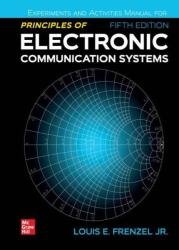 Название: Experiments Manual for Principles of Electronic Communication Systems, 5th Edition
Название: Experiments Manual for Principles of Electronic Communication Systems, 5th EditionАвтор: Louis E. Frenzel Jr.
Издательство: McGraw Hill
Год: 2023
Страниц: 271
Язык: английский
Формат: pdf, epub, mobi
Размер: 10.1 MB
This manual is to accompany the textbook Principles of Electronic Communications Systems (PECS), fifth edition. That text was written to support a one- or two-semester course in the fundamentals of communications systems including wireless and networking, both analog and digital. The text is written at the technology level and provides coverage for both 2-year community college and technical school programs through 4-year bachelor of technology programs. This manual serves as a supplement to the text and provides practical student activities as well as laboratory experiments, given the appropriate equipment.
There are always limits as to the extent of coverage of any textbook. Given practical page limits in addition to the time constraints of any college course, a text can cover only so much. The scope and breadth of coverage has been balanced with depth of coverage. However, this manual serves the instructor and the student in providing not only validation of principles in the text but also the opportunity to dig deeper on a variety of subjects with both Internet access and hands-on lab experiments.
Lab experiments are projects using actual electronic and/or computer hardware to demonstrate and validate key theoretical concepts. The goal is to provide a minimum of true hands-on practice with real test equipment, components, and related hardware. Most colleges have adequate lab equipment for teaching basic electronics as well as digital circuits and microcomputers. However, few have suitable lab equipment for teaching communications hardware. It is typically more expensive than basic instruments and trainers and can certainly be more difficult to use. Working with RF circuits and equipment is particularly challenging.
For these reasons, the lab experiments in the manual have been simplified as much as possible without compromising the teaching of the fundamentals. Furthermore, low cost was a key consideration in choosing the lab experiments. One way to do this is to use circuits that operate at much lower frequencies. Instead of VHF, UHF, and microwave signals that are the most common today, this manual uses low RF and in many cases audio and midrange frequencies below 1 MHz. This makes the circuits less expensive, less critical, and more adaptable to traditional breadboards. An effort has been made to use the older DIP ICs rather than the more common surface-mount devices so common in wireless and communications gear today. Finally, by using the lower frequencies, commonly available test equipment is typically acceptable.
Most communications receivers, regardless of size or application, are superheterodyne types. In addition, most of the gain and virtually all of the selectivity of the receiver is obtained in the IF section. The gain is easily obtained with transistor or IC amplifiers. The selectivity is more difficult as the IF passband must be carefully selected to match the signals being received and must, in most cases, have very steep skirt selectivity. In older receivers, selectivity was obtained with cascaded tuned transformers whose coupling was adjusted to give the desired bandwidth and steepness of response. These IF transformers were difficult to tune and adjust. Today, most IF selectivity is obtained with crystal filters or ceramic resonators. Some designs even use DSP filters. At very high frequencies, SAW filters are used. These filters are fixed during their manufacture to furnish a desired frequency response. Very steep selectivity is readily obtained in a very small package at low cost, and no tuning or adjustment is required.
Contents:
Introduction
Introduction to Electronic Communication
Electronic Fundamentals for Communications
Amplitude Modulation Fundamentals
Amplitude Modulation and Demodulation Circuits
Fundamentals of Frequency Modulation
FM Circuits
Radio Transmitters
Communication Receivers
Digital Data Transmission
Multiplexing, Duplexing, and Multiple Access
Transmission Lines
Fundamentals of Networking, Local Area Networks, and Ethernet
Antennas and Wave Propagation
Internet Technologies
Microwave and Millimeter-Wave Communication
Satellite Communication
Optical Communication
Cell Phone Technologies
Wireless Technologies
Communication Tests and Measurements
Appendix A Breadboarding
Appendix B GROL Review/Final Exam
Скачать Experiments Manual for Principles of Electronic Communication Systems 5th Edition